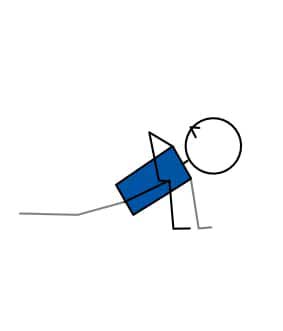Pilates Low Lunge Twist (Twisted Dragon) FAQs
[br]
What are the top 5 benefits of Low Lunge Twists?
A) Hip opener.
B) Back leg stretch.
C) Hip flexor stretch.
D) Quad stretch.
E) Eases sciatica.
[br]
What are the top 8 variations of Low Lunge Twists?
[br]
A) Place a blanket under the knee.
B) Raise the knee by putting a bolster under the shin.
C) Rest the shin on a bolster.
D) Tuck the toes under and lift the leg off the floor.
E) Baby Dragon (rest your hands on blocks).
F) Dragon Flying High (rest the arms or hands on the front thigh and lift the chest, increasing the weight over the hips).
G) Dragon Flying Low (place both hands inside the front foot and walk the hands forward, lowering the hips. To go deeper into the pose, lower down onto the elbows or rest them on a bolster or block.
H) Twisted Dragon Push (one hand pushes the front knee to the side, while the chest rotates to the ceiling.
[br]
What theme could I use if including Twisted Dragon in my pilates lesson plan?
I love turning my pilates lesson plans into memorable themes for my students. This pose is easy to turn into a theme. Firstly, no other mythological creature is mightier than the dragon. Secondly, dragons are so widely known that there are nine kinds of them, including the earth, wind, fire, water, sea, sky, golden, mountain, and the heavenly dragon. Dragons are also a symbol of power, strength, change, vitality, majesty, and longevity. And last but not least, dragons can represent a challenge to overcome (like old fables of heroes conquering dragons to save what is important to them). There you go! Lots of dragon themes for your next Pilates lesson plan.
[br]
What are the main contra-indications?
Twisted Dragon Pose can be uncomfortable for your bony kneecap or ankle. There's a simple solution to this. Support the back knee with a blanket, or place a bolster under the shin which raises the back knee off the floor.
[br]
Which joints will be getting a good workout?
Your hips and ankle joints will thank you after you've practised Twisted Dragon Pose.
[br]
What Are Some Teaching Tips For Twisted Dragon Pose?
[br]
"While in the Twisted Dragon, take your awareness to the part of the body that feels stiff (e.g. pelvis, hips, inner thighs, ankles, knee, shoulders, chest, upper abdomen, upper back, arms, and neck)."
"Stay in the Twisted Dragon for three full breaths. Focus on breathing deep and slow, helping the mind to remain calm."
"If you have a stiff neck, keep your gaze on the mat (don't look up)."
[br]
What other standing twist exercises can I teach my students?
All Pilates teachers know that a strong core is good to prevent back pain. The weaker the core, the more work the back muscles and soft tissues have to put in. Most students find Pilates Twists such as challenging, but enjoyable. So, don’t shy away from giving your students a Pilates Twist Challenge.
[br]
What are the benefits of Pilates Twist Exercises?
Aid digestion
Twists are said to aid digestion
Create space between the vertebra
Twists create space between the vertebrae which improves posture.
Detoxifying
Twists are detoxifying because of the squeeze and soak action.
Improved posture leads to reduces anxiety
Twists improve posture by creating more space in your spine. More space in your spine means better posture, and better posture means less anxiety.
Instant energy hit
Twists are a bit like eating pasta – they give an instant energy lift. Whenever your energy is low, if you do a twist you’ll instantly top up your energy supplies.
Long & healthy soft tissue
Twists help supportive soft tissue go from short and dysfunctional, to long and healthy (twists extend muscles to their full length).
Oil or Joints
Twists prevent joints from hardening and fusing.
Perfect counter pose for forward & back bends
Twists are perfect poses to do immediately after a bunch of strong back bends and/or forward bends.
Spine mobility
Twists rotate the spine and stretch back muscles.

